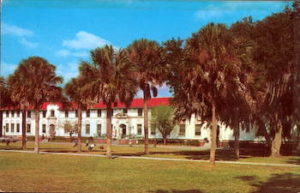
St. Augustine School for the Deaf and the Blind
*This date in 1885 celebrates the opening of the St. Augustine School for the Deaf and the Blind (FSDB), a state-supported boarding school for deaf and blind children established in St. Augustine, Florida.
In 1882, Thomas Hines Coleman, a young deaf man, was preparing to graduate from Gallaudet University in Washington, D.C., the only college for people who are deaf or hard of hearing. He had graduated from the South Carolina School for the Deaf and Blind and knew he wanted to make education for children his life's work. Florida was one of the few states that had not made provision for the education of children who were deaf/hard of hearing or who had visual impairments. Coleman wrote the Governor favorably toward establishing such a school, and $20,000 was reached as a minimum appropriation. In 1883, Florida's legislature requested bids from towns in the state for the school's location. St. Augustine offered $1,000 cash and 5 acres of land donated.
The original first three wooden buildings came in December 1884. The School for the Blind, Deaf, and Dumb opened with black and white children. Jim Crow laws opposing racial integration were rampant in its early years, and the Florida Institute for the Blind, Deaf, and Dumb, Colored Department was created in 1895. By 1892, 62 students were enrolled, and the first graduation ceremony for two white deaf students, Artemas W. Pope and Cora Carlton, was in 1898. The first graduation for a white blind student, DeWitt Lightsey, was held in 1898, and the first for a black blind student, Louise Jones, was in 1914. The school was under the direction of a five-member board of trustees until 1905.
The first graduation for a black deaf student, Cary White, was in 1925. In 1936, Ray Charles attended St. Augustine School, where he learned to read Braille. In 1967, the school was integrated into the Florida School for the Deaf and the Blind. Their present seven-member Board of Trustees came in 1963. Construction began on new dormitories in 1958, opening in 1959. The school is now the largest in the United States, with 47 buildings on 82 acres. The school currently has an annual budget of over $30 million. Through the statewide Parent-Infant Program, it serves 600 students on campus and 400 infants/toddlers and their parents.
FSDB is Florida's primary public school for children who are deaf or blind. Students are transported to the school and back home, residing in dormitories during the week. The school serves deaf and blind students in pre-school through 12th grade and has a post-secondary program. They are accredited by the Southern Association of Colleges and Schools, the Conference of Educational Administrators Serving the Deaf, and the National Accreditation Council for Agencies Serving the Blind and Visually Handicapped. FSDB has two departments: The Deaf Department serves children who are deaf or hard of hearing, and the Blind Department serves children who are blind or visually impaired.
In addition, outreach programs support parents, teachers, and other staff in Florida's small and rural school districts. They have a health care center for students and two well-appointed auditoriums on campus. Blind high school students can take a sound engineering elective and have opportunities to work with state-of-the-art sound systems within the school. They offer ASL courses to the community for a nominal fee and are members of the Florida High School Athletic Association (FHSAA). Students can compete in 11 team sports with public and private schools across the state and nation.
School personnel work with about 300 student-athletes each year. Athletic teams include basketball, cheerleading, cross country, flag football, goalball, soccer, swimming, track & field, volleyball, and wrestling. FSDB has three gyms, a swimming pool, two bowling alleys, and the Copeland Recreation and Fitness Center, specially designed and constructed for the blind. The Copeland Center is the site of the annual USABA (United States Association of Blind Athletes) Youth National Goalball Tournament. The school's Deaf Department has a traveling Dance Troupe, and the Blind Department has a band known as OuttaSight. Other clubs and activities include: